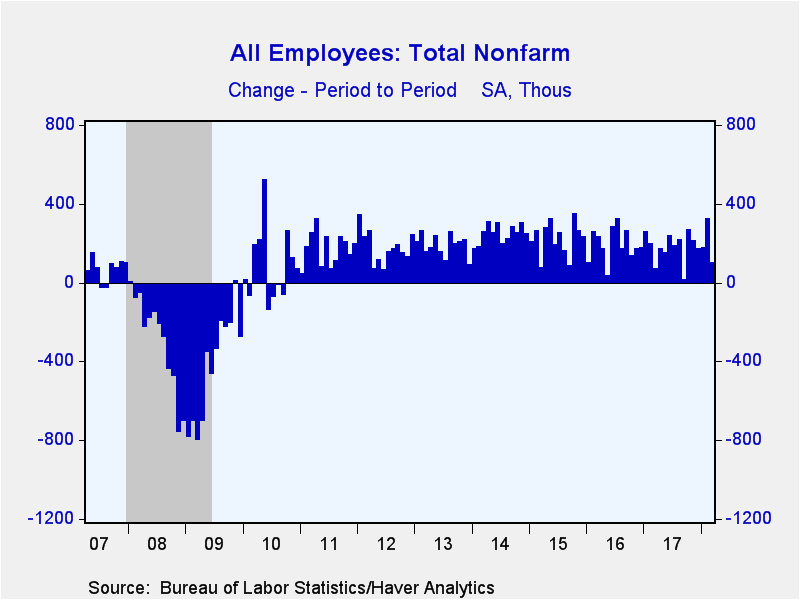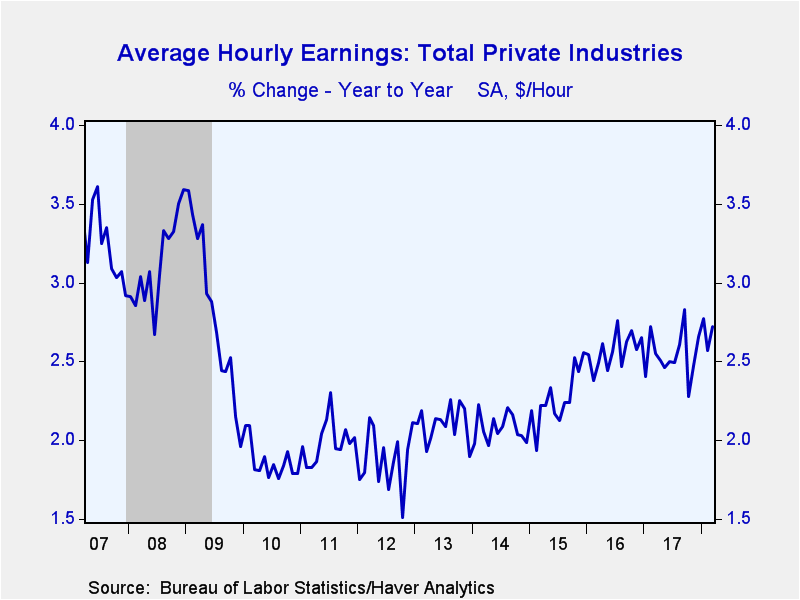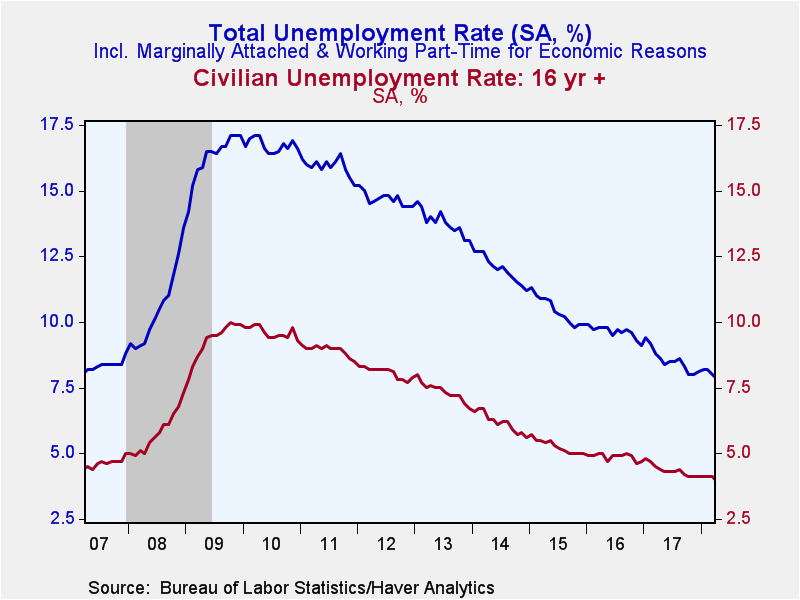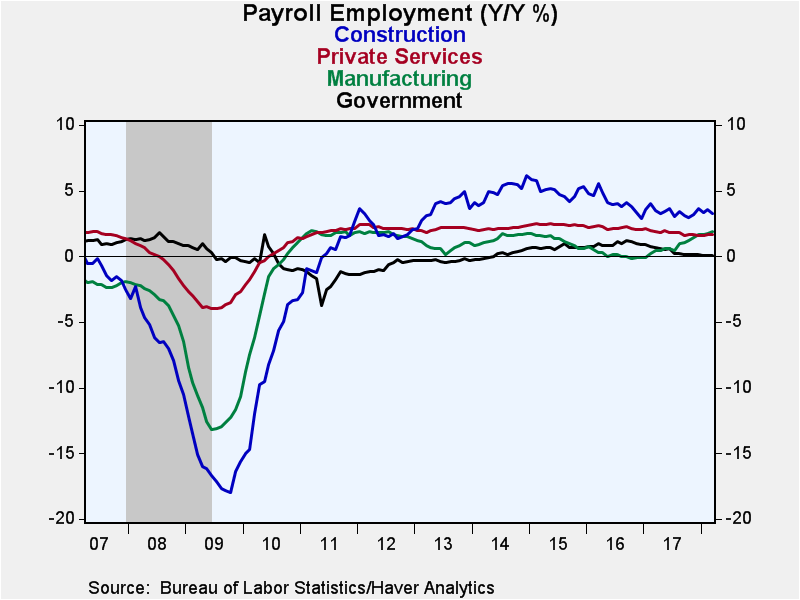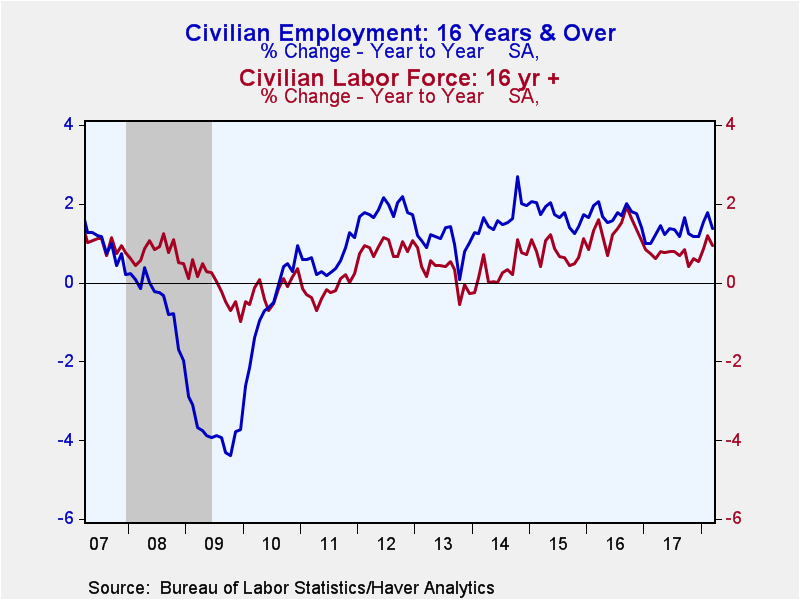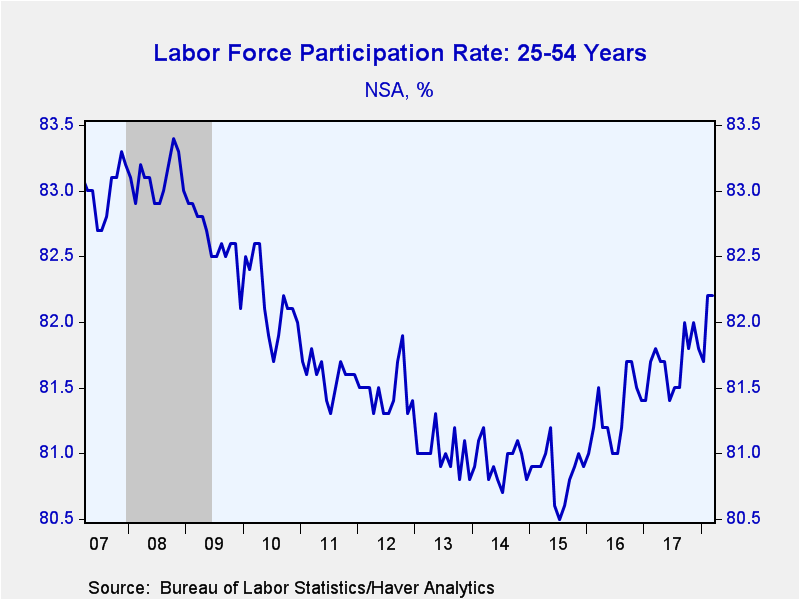 Global| Apr 06 2018
Global| Apr 06 2018U.S. Payroll Increase Weakens; Wage Gain Accelerates
by:Tom Moeller
|in:Economy in Brief
Summary
The job market cooled off last month. Nonfarm payrolls rose 103,000 (1.6% y/y) during March following a 326,000 February gain and a 176,000 January increase. Together these two figures were revised down by 50,000. A 195,000 increase [...]
The job market cooled off last month. Nonfarm payrolls rose 103,000 (1.6% y/y) during March following a 326,000 February gain and a 176,000 January increase. Together these two figures were revised down by 50,000. A 195,000 increase in payrolls had been expected in the Action Economics Forecast Survey. Average hourly earnings strengthened 0.3% (2.7% y/y) following unrevised gains of 0.1% and 0.3% in the prior two months. A 0.2% rise had been expected.
The unemployment rate held steady at 4.1% for a sixth straight month. A dip to 4.0% had been expected. The overall unemployment rate, including the marginally-attached and those working part-time for economic reasons, fell to 8.0%, down from 8.8% one year earlier.
From the payroll employment survey, the 103,000 increase in jobs was the weakest rise in six months. The average 215,000 gain during the last two months, however, was up slightly from last year's monthly average of 182,000. Construction sector jobs declined 15,000 (+3.7% y/y) following a 65,000 increase. Factory sector employment increased 22,000 (1.9% y/y) after strength during six of the prior seven months. Mining sector payrolls strengthened 8,500 (10.1% y/y) after a 9,000 rise.
Private service-producing employment rose 87,000 (1.7% y/y) after a 214,000 surge. The two-month average was fairly steady at 151,000. Professional & business services employment rose 33,000 (2.5% y/y) after a 55,000 increase. Temporary help employment eased 600 (+3.8% y/y) after a 21,000 rise. Jobs in the education & health services sector increased 25,000 (1.9% y/y), the weakest rise since October. The number of trade, transportation & utilities jobs increased 21,000 (1.1% y/y) after a 74,00 increase, as retail employment declined 4,400 (0.4% y/y) following a 47,000 surge. Leisure & hospitality jobs rose a negligible 5,000 (1.9% y/y) following a 24,000 average increase during the prior four months. Financial activities employment gained 2,000 (1.6% y/y) after an out-sized 30,000 jump. Information sector employment improved 2,000 (-1.9% y/y) and reversed the prior month's decline.
Public sector employment notched 1,000 higher after a 6,000 rise, but was unchanged y/y. Local government jobs improved 3,000 (0.5% y/y) after an 18,000 rise. State government employment fell 1,000 (-1.0% y/y) after several months of decline, while federal government employment eased 1,000 (-0.7% y/y) after a 7,000 drop.
The 0.3% rise (2.7% y/y) in average hourly earnings followed accelerated gains between 0.3% and 0.4% in the three of the prior four months. Financial activities earnings strengthened 0.6% (5.3% y/y) following no change in February. Professional & business services pay improved 0.5% (2.3% y/y) after no change. Leisure & hospitality pay grew 0.4% (3.0% y/y) after a 0.1% uptick. Trade, transportation & utilities earnings rose 0.3% (2.2% y/y) after little change in the prior two months. Information sector earnings ticked just 0.1% higher (3.8% y/y) after two months of 0.3% increase.
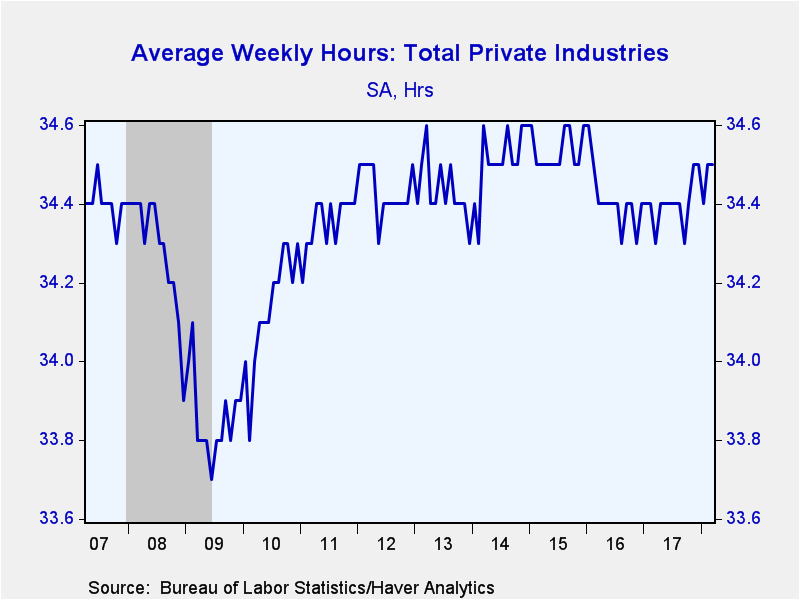 The length of the average workweek held steady at 34.5 hours,
up from an average 34.4 hours during both 2017 and 2016. Mining & logging
sector hours of 46.0 hours compared to 45.2 hours last year. Factory sector
hours of 40.9 have been fairly steady for three years. The construction sector
workweek increased to 39.2 hours from an average 39.1 hours last year. Financial
sector hours were stable for the last five months at 37.6. Education &
health services hours fell m/m to 32.9 hours, but equaled the average in the last two years.
The length of the average workweek held steady at 34.5 hours,
up from an average 34.4 hours during both 2017 and 2016. Mining & logging
sector hours of 46.0 hours compared to 45.2 hours last year. Factory sector
hours of 40.9 have been fairly steady for three years. The construction sector
workweek increased to 39.2 hours from an average 39.1 hours last year. Financial
sector hours were stable for the last five months at 37.6. Education &
health services hours fell m/m to 32.9 hours, but equaled the average in the last two years.
In the household sector survey, the stable 4.1% jobless rate reflected a 37,000 decline in employment after a 785,000 jump, and 158,000 decline in the labor force following an 806,000 strengthening. The labor force participation rate eased to 62.9%, but remained up from the 2015 low of 62.3%. For those aged 25-54 it held m/m at 82.2%, up from 80.8% in 2015. The average duration of unemployment rose to 24.1 weeks, but remained down from 39.4 weeks in 2012.
By educational attainment, the unemployment rate for individuals without a high school diploma declined to 5.5% while high school graduates with no college were 4.3% unemployed. Those with less than a bachelors degree realized 3.6% joblessness, and individuals with a bachelors degree or higher were 2.2% out of work.
The teenage unemployment rate of 13.5% compared to 6.6% for those aged 20-24 years. Individuals aged 25-54 years old were 3.5% unemployed, while those over age 55 were 3.2% jobless.
The labor market data are contained in Haver's USECON database. Detailed figures are in the EMPL and LABOR databases. The expectations figures are in the AS1REPNA database.
The Outlook for the U.S. Economy is the title of today's speech by Fed Chairman Jerome H. Powel and it can be found here.
| Employment: (SA, M/M Change, 000s) | Mar | Feb | Jan | Mar Y/Y | 2017 | 2016 | 2015 |
|---|---|---|---|---|---|---|---|
| Payroll Employment | 103 | 326 | 176 | 1.6% | 1.6% | 1.8% | 2.1% |
| Previous Estimate | -- | 313 | 239 | -- | -- | -- | -- |
| Manufacturing | 22 | 32 | 20 | 1.9 | 0.7 | 0.1 | 1.2 |
| Construction | -15 | 65 | 28 | 3.7 | 2.4 | 4.1 | 5.0 |
| Private Service-Producing | 87 | 214 | 133 | 1.7 | 1.8 | 2.2 | 2.4 |
| Government | 1 | 6 | -12 | 0.0 | 0.4 | 0.9 | 0.7 |
| Average Weekly Hours - Private Sector | 34.5 | 34.5 | 34.4 | 34.3 | 34.4 | 34.4 | 34.5 |
| Private Sector Average Hourly Earnings (%) | 0.3 | 0.1 | 0.3 | 2.7 | 2.5 | 2.6 | 2.3 |
| Unemployment Rate (%) | 4.1 | 4.1 | 4.1 | 4.5 | 4.4 | 4.9 | 5.3 |
Tom Moeller
AuthorMore in Author Profile »Prior to joining Haver Analytics in 2000, Mr. Moeller worked as the Economist at Chancellor Capital Management from 1985 to 1999. There, he developed comprehensive economic forecasts and interpreted economic data for equity and fixed income portfolio managers. Also at Chancellor, Mr. Moeller worked as an equity analyst and was responsible for researching and rating companies in the economically sensitive automobile and housing industries for investment in Chancellor’s equity portfolio. Prior to joining Chancellor, Mr. Moeller was an Economist at Citibank from 1979 to 1984. He also analyzed pricing behavior in the metals industry for the Council on Wage and Price Stability in Washington, D.C. In 1999, Mr. Moeller received the award for most accurate forecast from the Forecasters' Club of New York. From 1990 to 1992 he was President of the New York Association for Business Economists. Mr. Moeller earned an M.B.A. in Finance from Fordham University, where he graduated in 1987. He holds a Bachelor of Arts in Economics from George Washington University.


